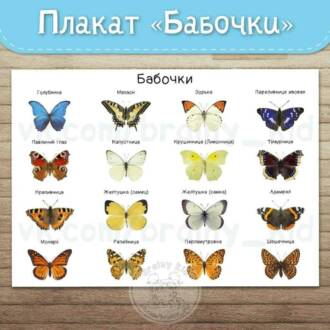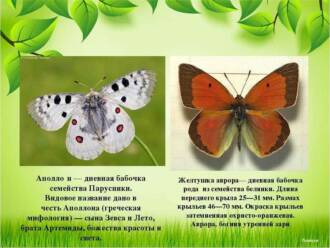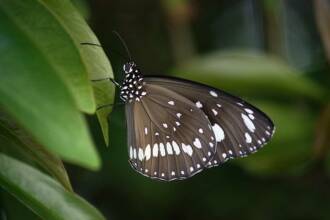Diurnal butterfly, Nymphalidae family. In science, this beautiful butterfly is called Vanessa atalanta. The butterfly Admiral has velvety black wings (span 5-6 cm). Many insects are similar to each other. Butterfly admiral resembles hives, but they look more refined and brighter. Her visiting card is the characteristic orange ribbons on the wings, thanks to which the insect got its unusual name.

Story
A rich palette of colors and intricate patterns on the wings distinguish butterflies from other insects. It is no wonder that these sublime creatures are given the names of the heroes of ancient myths. Butterfly Admiral is called so in honor of Vanessa Atalanta (from lat. Vanessa atalanta). Carl Linnaeus chose for the new species the name of the daughter of the hero Schenei, who dreamed of a son. In ancient Greece, it was believed that an upset father got rid of Vanessa by throwing her off a mountain. A beautiful girl spent her life in the forest. See what are the types of butterflies.
There are two versions of the origin of the name Admiral. According to the first, the name comes from the Turkish word, which translates as "lord of the seas." Although the butterfly prefers to live in meadows, it easily embarks on long journeys and flies over water bodies.
The second version is marine - the insect was so called because of the color. Red stripes on a dark background resemble admiral's ribbons - such were the commanders of the fleet.
In crossword puzzles, there is a question about a naval butterfly. If you see him, then try to substitute the word "admiral".

Description
A short description will help you to recognize this butterfly in natural conditions. Since 2018, the population in Russia has grown, which means that the likelihood of meeting this colorful insect has increased.
What does an admiral butterfly look like? The color of the wings, reaching from 5 to 6.5 cm in span, varies from brown to black. On a dark background, elegant white spots of bizarre shapes located on the tops stand out effectively. This is a red admiral butterfly, common in North America and Eurasia.

An insect belonging to the Nymphalidae family is easily recognizable in the photo by the characteristic red band that crosses the front wings. The backs show similar bright lines running along the outer edge. From below, these parts of the body are not so bright. Spots of red and white are scattered on a brown-brown background. The underside of the back is also brown, but the pattern is different - it is marbled. All four wings have the same edging - a white stripe passes through them.
Butterfly firefighter - they talk about moths with bright colors. So the admiral can also be said about the butterfly.
The back is brown or black. The abdomen is lighter - usually it is light brown or tobacco. On each of the three parts of the breast is a pair of limbs.
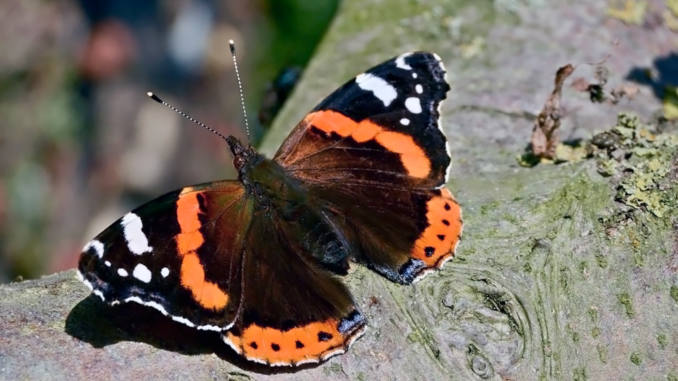
The red admiral is a butterfly with large eyes located on the sides of its head. They are designed in such a way that you do not have to turn your head to see the surroundings. Insects distinguish blue, yellow and green colors. The exception is red. Butterflies simply ignore him.
In addition to vision, admirals have a well-developed sense of smell - the segmented antennae on their foreheads are able to detect odors at great distances. The basis of the diet is nectar. Butterflies eat with the help of a proboscis, which, when at rest, is folded into a spiral.
The paws are equipped with sensitive fibers. They have taste buds. When an insect lands on a flower or fruit, the admiral uses them to make the first test to verify the quality of the food.

This insect is included in family nymphalidae. Read more about the classification of butterflies. With other representatives, it is united by the following features:
- Veins on wings without thickening.
- The front paws are shortened, they have brushes.
- The admiral has no claws.
TO Lepidoptera these insects are related because of the characteristic scales on the wings, which are arranged like tiles.
reproduction
Butterflies of this species go through a full cycle of transformation. Reproduction begins with a courtship period. Males strive to occupy large territories - they win back plots from weak competitors, the size of which is approximately 10 by 20 meters. Opponents are "exhausted" by males by flying in a vertical spiral, and then expelled. After that, they most often sit on leaves or branches bathed in sunlight, and wait for a meeting with their “soul mate”. Females do not suffer from a lack of attention. Males are active during mating games, constantly flying around until they achieve location. When mating occurs, butterflies are vulnerable - they disconnect from reality and do not react to events around them.

After mating, the butterfly lays an egg on a host plant. This process takes a lot of time and takes away the strength of the female. Therefore, it can be interrupted to refresh itself with nectar. Typically, admirals choose nettles, thistles or hops for procreation.
The size of the egg is not more than 0.8 mm. This stage lasts for a week. The darkening of the color indicates the proximity of the next stage. The caterpillar of the admiral who has appeared chooses a leaf as a dwelling. She folds it and fastens it with a web. On the side of the body of the insect are yellow stripes, dots and spikes. The admiral butterfly caterpillar comes in the following colors:
- green-yellow;
- black;
- brown;
- red.

This coloring saves the admiral butterflies from predators - the caterpillar of the admiral butterfly "merges" with the plants. Pupation occurs when the insect reaches 30 mm in length. The color of the pupa, suspended upside down, is gray-brown. The butterfly appears after about 14 days. The duration of the phase depends on the temperature conditions. At 30°C, it takes only a week, at 12°C, the process is delayed up to a month.
How long does an admiral butterfly live? Lifespan in all stages usually reaches 10 months. Part of this period the insect is in hibernation.
Admirals are bred at home. They are kept in aquariums or special containers. To grow a healthy insect in an apartment, the caterpillar needs to be provided with fodder plants, create the necessary temperature conditions for it and maintain high humidity.
Features of life
Butterflies admirals are constantly on the move. On warm sunny days, they are found in gardens, parks and near water bodies. It is difficult to see an adult individual - disguise works so well. Insects are not afraid of people - the butterfly easily sits on the palm or shoulder of a person. Take a close look at the individual. In moths that have arrived from other places, the color is not so saturated, the wings are faded. The locals have bright colors on the contrary, the picture is always the same.
Predators are dangerous for an insect at every stage of development. The following enemies of admirals in nature are known:
- the bats;
- birds;
- spiders;
- ants;
- wasps;
- frogs;
- lizards.
Not all predators are at risk of associating with this species. Birds are frightened by the bright color of butterflies and the spikes of hairy caterpillars. Only cuckoos eat larvae without fear.
What does the admiral butterfly eat? Caterpillars prefer nettles and thistles, while moths feed on the nectar of cornflower and flowering hops. Bright insects choose red clover, alfalfa and aster. Fermented fruits - a favorite dish is sweet. Admirals love overripe fruits and enjoy the nectar of cracked peaches and plums.
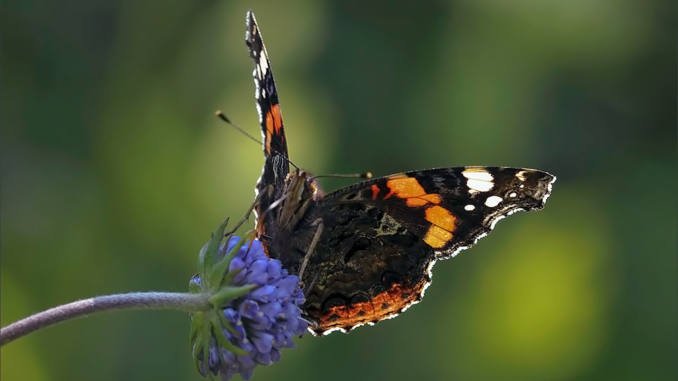
Habitat and migration
During migration, butterflies rise high so that the wind picks them up and helps them reach their destination faster. Flight speed - up to 15 km / h. Insects travel great distances, they can fly to Africa from Europe.
The habitat is varied. Butterfly admiral chooses warm places. She prefers to winter in Haiti, Guatemala, in the north of America and the islands of the Atlantic Ocean. Insects sometimes stay during the cold season in Scandinavia. Butterflies find a shelter in which they spend time until spring. Such a shelter becomes the bark of trees and cracks in buildings. In the spring, the admiral wakes up transformed - the color becomes brighter during the rest. However, the insect does not always hibernate. In regions with a mild climate, a bright moth is seen on sunny days even in winter.
"Summer time" refers to the season in which they are active. It varies depending on climatic conditions. In the southern countries, admirals can be seen from the beginning of May until the end of October. In other territories, the summer time is usually from June to September.
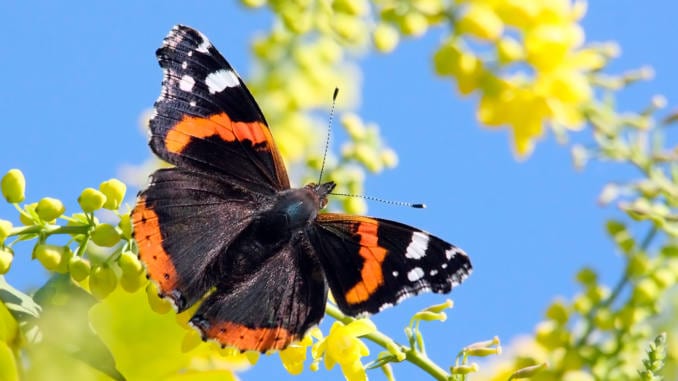
Security
In Russia, the admiral butterfly was not common - the population has seriously decreased due to the treatment of fields with chemicals. The Red Book contained information about it since 1997, but then the species was excluded from the publication. The situation remains difficult only in the Smolensk region. In this area, the population has a declining status.
In 2018, the number of admirals increased significantly in the European part of the country. Scientists say that such rapid ups and downs in numbers occur in most insects. Why is that? There are many factors that are difficult to predict. Scientists identify the following two most popular factors, explaining the natural phenomenon briefly:
- If frost occurs at the beginning of summer, fewer individuals are born.
- Parasitoid insects use caterpillars to feed their own offspring. When the number of such pests decreases, the number of butterflies increases.

Butterfly life is negatively affected by deforestation, plowing of meadows and the use of chemicals to treat plantings. In Russia, admirals are most often found in meadows, along roads, near forests, and also in mountainous areas. Butterflies live in the Urals and the Eastern Caucasus, in Karelia and the Central part of the country. In recent years, insects with colorful wings have become frequent guests on the shores of the White Sea. Locals say that this is a real invasion.
A butterfly chooses a habitat for a reason. The number of generations depends on it - offspring can be from one to three per year.
The climatic conditions of most regions of Russia are not suitable for fastidious insects. Admiral is one of the few exceptions. Butterfly with bright colors, similar to the bud of an exotic flower, pleases the eye from spring to autumn. A fragile insect does not harm cultivated plants. Therefore, do not rush to get rid of hairy caterpillars if you suddenly see them in the garden or on the beds, because soon it will turn into a colorful butterfly with an unusual marine name. Read more about what are the benefits of butterflies.
On the front wings in the corners are white spots, which are cut off by a bright red stripe. The same stripe runs along the edge of the lower wing. For these stripes, the butterfly got its name: in the old days, admirals had red stripes on their trousers, and they wore red ribbons over their shoulders.

The caterpillar of the Admiral is brown-red, with yellow stripes, spikes and dots. They live on the leaves of nettles and thistles. Butterfly Admiral is found on forest edges, glades, meadows, on the sunny banks of rivers, along roadsides. Flight time is from May to October.

